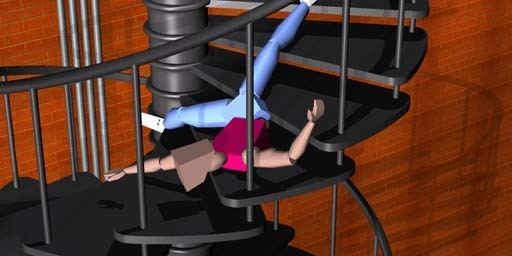 | ||
In computer physics engines, ragdoll physics is a type of procedural animation that is often used as a replacement for traditional static death animations in video games and animated films.
Contents
Introduction
Early video games used manually created animations for characters' death sequences. This had the advantage of low CPU utilization, as the data needed to animate a "dying" character was chosen from a set number of pre-drawn frames. As computers increased in power, it became possible to do limited real-time physical simulations. A ragdoll is therefore a collection of multiple rigid bodies (each of which is ordinarily tied to a bone in the graphics engine's skeletal animation system) tied together by a system of constraints that restrict how the bones may move relative to each other. When the character dies, their body begins to collapse to the ground, honouring these restrictions on each of the joints' motion, which often looks more realistic.
The term ragdoll comes from the problem that the articulated systems, due to the limits of the solvers used, tend to have little or zero joint/skeletal muscle stiffness, leading to a character collapsing much like a toy rag doll, often into comically improbable or compromising positions.
The Jurassic Park licensed game Jurassic Park: Trespasser exhibited ragdoll physics in 1998 but received very polarised opinions; most were negative, as the game had a large number of bugs. It was remembered, however, for being a pioneer in video game physics.
Modern use of ragdoll physics goes beyond death sequences—there are fighting games where the player controls one part of the body of the fighter and the rest follows along, such as Rag Doll Kung Fu, and even racing games such as the FlatOut series.
Recent procedural animation technologies, such as those found in NaturalMotion's Euphoria software, have allowed the development of games that rely heavily on the suspension of disbelief facilitated by realistic whole-body muscle/nervous ragdoll physics as an integral part of the immersive gaming experience, as opposed to the antiquated use of canned-animation techniques. This is seen in Grand Theft Auto IV, Grand Theft Auto V, Red Dead Redemption and Max Payne 3 as well as titles such as LucasArts' Star Wars: The Force Unleashed, and Puppet Army Faction's Kontrol, which features 2D powered ragdoll locomotion on uneven or moving surfaces.
Approaches
Ragdolls have been implemented using Featherstone's algorithm and spring-damper contacts. An alternative approach uses constraint solvers and idealized contacts. While the constrained-rigid-body approach to ragdolls is the most common, other "pseudo-ragdoll" techniques have been used:
